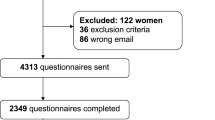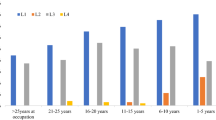Abstract
Aims
We investigated the involvement of first-time mothers, who had a planned Caesarean section, in the decision to have a Caesarean section, taking into account their different educational levels.
Subjects and methods
A self-assessment questionnaire was sent in July 2005 to women who had undergone a Caesarean section in 2004. Participants were 2,685 members of a statutory health insurance fund who had given birth by Caesarean section (response rate: 48.0%). Included were primiparae with planned Caesarean section (n = 352).
Results
The women in this cross-sectional study felt well informed about the procedure of a section but not its consequences. They used several sources of information and were most satisfied with the information provided by doctors and midwives. Of the women in this study 20% did not have a midwife. No major differences were observed between different educational levels.
Conclusion
Although most women were satisfied with their decision, they felt that they did not receive enough information about the consequences of a Caesarean section. This information need could be met by a further involvement of midwives in maternity care.
Similar content being viewed by others
References
American College of Obstetricians and Gynecologists (2004) Ethics in obstetrics and gynecology, 2nd edn. American College of Obstetricians and Gynecologists, Washington DC
Beisecker AE, Beisecker TD (1990) Patient information-seeking behaviors when communicating with doctors. Med Care 28:19–28
BQS Bundesgeschäftsstelle Qualitätssicherung (2008) BQS Auswertung 2007 Geburtshilfe. http://www.bqs-outcome.de/2007/ergebnisse/leistungsbereiche/geburtshilfe/buaw. Accessed 22 Jul 2008
Charles C, Whelan T, Gafni A (1999) What do we mean by partnership in making decisions about treatment? BMJ 319:780–782
Denk CE, Kruse LL, Jain NJ (2006) Surveillance of caesarean section deliveries, New Jersey, 1999–2004. Birth 33:203–209
Ende J, Kazis L, Ash A, Moskowitz MA (1989) Measuring patients’ desire for autonomy: decision making and information-seeking preferences among medical patients. J Gen Intern Med 4:23–30
Enkin M, Keirse MJNC, Neilson J et al (2000) A guide to effective care in pregnancy and childbirth, 3rd edn. Oxford University Press, Oxford
Fleissig A (1993) Are women given enough information by staff during labour and delivery? Midwifery 9:70–75
Freda CM, Andersen HF, Damus K, Merkatz IR (1993) What pregnant women want to know: a comparison of client and provider perceptions. J Obstet Gynecol Neonatal Nurs 22:237–244
Glaeske G, Janhsen K (2008) Der GEK-Arzneimittelreport 2008. Asgard, St. Augustin
Graham WJ, Hundley V, McCheney AL, Hall MH, Gurney E, Milne J (1999) An investigation of women’s involvement in the decision to deliver by caesarean section. Br J Obstet Gynaecol 106:213–220
Horey D, Weaver J, Russel H (2004) Information for pregnant women about cesarean birth. Cochrane Database Syst Rev 2004, Issue 1. Art. No. CD003858. doi:10.1002/14651858.CD003858.pub2
Sagadyleslie M (2004) Counseling women about elective cesarean section. J Midwifery Womens Health 49:155–159
Liu S, Liston RM, Joseph KS, Heaman M, Sauve R, Kramer MS, Maternal Health Study Group of the Canadian Perinatal Surveillance System (2007) Maternal mortality and severe morbidity associated with low-risk planned cesarean delivery versus planned vaginal delivery at term. CMAJ 176:455–460
Lutz U, Kolip P (2006) Die GEK-Kaiserschnittstudie. Schriftenreihe zur Gesundheitsanalyse, Band 42. Asgard, St. Augustin
McFarlin BL (2004) Elective cesarean birth: issues and ethics of an informed decision. J Midwifery Womens Health 49:421–429
Menacker F, Declerq E, Macdorman MF (2006) Cesarean delivery: background, trends, and epidemiology. Semin Perinatol 30:235–241
Mould TAJ, Chong S, Spencer JAD, Gallivan S (1996) Women’s involvement with the decision preceding their caesarean section and their degree of satisfaction. Br J Obstet Gynaecol 103:1074–1077
NICE - National Institute for Clinical Excellence 2004 Caesarean section. Clinical Guideline 13. http://www.nice.org.uk/page.aspx?o=113192. Accessed 20 Jul 2008
Niedersächsische Perinatalstatistik, Geburtskohorte 2004. Available at: http://www.zq-aekn.de
O’Cathain A, Thomas K, Walters SJ, Nicholl J, Kirkham M (2002) Women’s perceptions of informed choice in maternity care. Midwifery 18:136–144
OECD Health Data 2006. http://www.gbe-bund.de/ -> Kaiserschnitt. Accessed 27 Jul 2008
Scheibler F, Janßen C, Pfaff H (2003) Shared-decision making: Ein Überblicksartikel über die internationale Forschungsliteratur. Soz Präventivmed 48:11–23
Stapleton H, Kirkham M, Thomas G (2002) Qualitative study of evidence based leaflets in maternity care. BMJ 324:639
Tollånes MC, Thompson JM, Daltveit AK, Irgens LM (2007) Cesarean section and maternal education; secular trends in Norway, 1967–2004. Acta Obstet Gynecol Scand 86:840–888
Turnbull DA, Wilkinson C, Yaser A, Carty V, Svigos JM, Robinson JS (1999) Women’s role and satisfaction in the decision to have a caesarean section. Med J Aust 170:580–583
Wensing M, Elwyn G, Edwards A, Vingerhoets E, Grol R (2002) Deconstructing patient centred communication and uncovering shared decision making: an observational study. BMC Med Inform Decis Mak 2:2
Acknowledgements
The study was funded by the Gmünder Ersatzkasse, a German health insurance fund.
Conflict of interest
The authors confirm that there are no relevant associations that might pose a conflict of interest.
Author information
Authors and Affiliations
Corresponding author
Rights and permissions
About this article
Cite this article
Kolip, P., Büchter, R. Involvement of first-time mothers with different levels of education in the decision-making for their delivery by a planned Caesarean section. Women’s satisfaction with information given by gynaecologists and midwives. J Public Health 17, 273–280 (2009). https://doi.org/10.1007/s10389-008-0246-1
Received:
Accepted:
Published:
Issue Date:
DOI: https://doi.org/10.1007/s10389-008-0246-1




